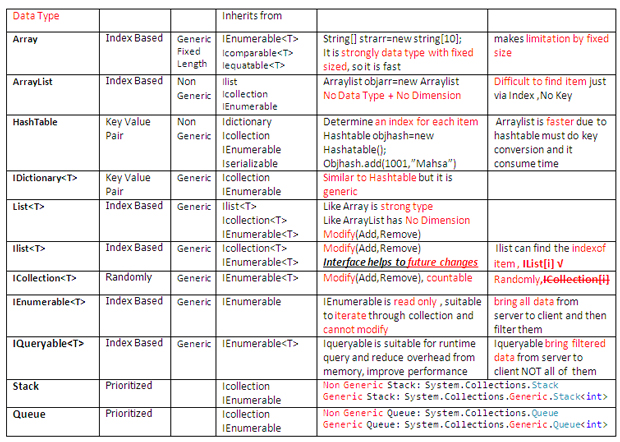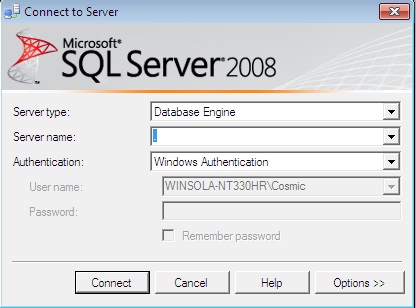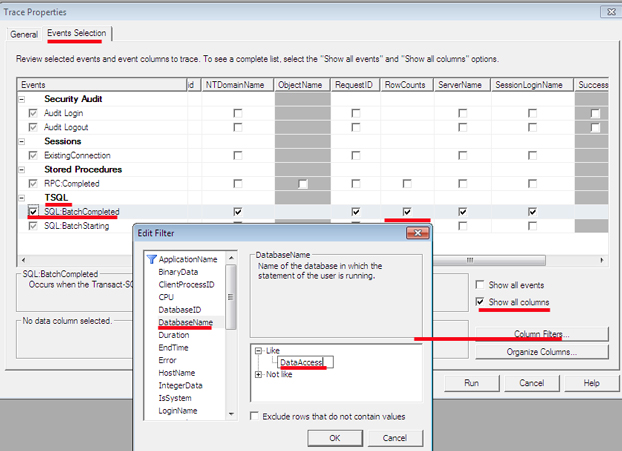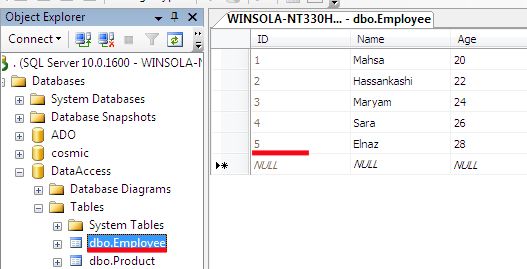最全数据结构详述: List VS IEnumerable VS IQueryable VS ICollection VS IDictionary
本文对常用的数据结构详述:Array, ArrayList,List,IList,ICollection, Stack, Queue, HashTable, Dictionary, IQueryable, IEnumerable。

Collection(集合)
Collection是数据记录集合,
编写代码过程中,常常需要合适的容器保存临时数据,方便修改和查找,如何选取合适的数据容器,关键在于将执行的数据操作以及数据记录是否大量。

Array(数组)
特征
1. 固定大小,数组的大小是初始化时决定无法修改的数值。
2. 强类型,存储数据元素类型必须在初始化时指定,因此在运行时,不需要耗费额外的时间来定义数组类型,能够大大提升运行效率。
3. 可使用Foreach关键字实现数组迭代和查找。
因为数组大小是固定的,且是强类型数据结构,因此在运行时只占用很少的内存,运行时效率很高。

1: //It is obvious that strArray is
2: //1. string --> Strongly Type
3: //2. Sized=10 --> Fixed Size
4:
5: string[] strArray = new string[10];
6:
7: for (int i = 0; i < 10; i++)
8: {
9: if (strArray[i]==null)
10: {
11: strArray[i] = (i+1).ToString();
12: }
13: }
14:
15: this.ListBoxArray.DataSource = null;
16: this.ListBoxArray.Items.Clear();
17:
18: this.ListBoxArray.DataSource = strArray;
19: this.ListBoxArray.DataBind();
ArrayList
1. ArrayList 没有固定的长度,容量可动态增加,可应用于开发人员无法确定数组元素个数等场景,当然这种情况下,在定义结构体的时候会非常耗时。
2. ArrayList 不是强类型,ArrayList中不同元素类型可以不相同,并且需要在运行时根据实际的输入来确定元素类型。因此在运行时消耗内存较多。
3. 可使用Froeach 关键字操作ArrayList。

1: public class Product
2: {
3: public Product()
4: {
5:
6: }
7: public Product(string Code, string Name)
8: {
9: _Code = Code;
10: _Name = Name;
11: }
12:
13: public string _Code {get; set;}
14: public string _Name { get; set; }
15: }
ArrayList支持String,int,以及十进制小数类型。
1: //It is NOT obvious that strArrayList is 1. string? int? object? decimal? --> NOT Strongly Type
2: // 2. Sized=10? 20? 100? -->NOT Fixed Size
3: // Namespace: System.Collections
4:
5: System.Collections.ArrayList strArrayList = new System.Collections.ArrayList();
6: //System.Linq.IQueryable type of data is not specific runtime defered support
7: strArrayList.Add("Mahsa"); // "Mahsa": is string
8: strArrayList.Add(1); // 1 : is integer
9: strArrayList.Add(0.89); // 0.89: is decimal
10:
11: this.ListBoxArrayList.DataSource = null;
12: this.ListBoxArrayList.Items.Clear();
13: this.ListBoxArrayList.DataSource = strArrayList;
14: this.ListBoxArrayList.DataBind();
15:
16: System.Text.StringBuilder str= new System.Text.StringBuilder();
17:
18: foreach (var item in strArrayList)
19: {
20: str.Append(" , "+item);
21: }
22: this.lblArrayList.Text = str.ToString();
23:
24: //Below is old way to fill obj from product , in Arraylist you need to create more than one instance
25: // Product objProduct = new Product();
26: // objProduct.Code = "1001";
27: // objProduct.Name = "Chair";
28:
29: //It is NOT obvious that strArrayList is
30: //1. string? int? object? decimal? OR OBJECT?? --> NOT Strongly Type
31: //2. Sized=10? 20? 100? -->NOT Fixed Size
32: // Namespace: System.Collections
33:
34: System.Collections.ArrayList objArrayList = new System.Collections.ArrayList();
35:
36: objArrayList.Add(new Product("1001", "Chair"));
37: objArrayList.Add(new Product("1002", "Sofa"));
38: objArrayList.Add(new Product("1003", "Carpet"));
39:
40: this.DropDownListArrayListObject.DataSource = null;
41: this.DropDownListArrayListObject.Items.Clear();
42: this.DropDownListArrayListObject.DataSource = objArrayList;
43:
44: //* Finding among Object of Array List is difficult , you have to find your specific item by index
45: Product objTemp = (Product)objArrayList[0];
46: objArrayList.Remove(objTemp);
47: //*
48: this.DropDownListArrayListObject.DataTextField = "_Name";
49: this.DropDownListArrayListObject.DataValueField = "_Code";
50: this.DropDownListArrayListObject.DataBind();
51: this.GridViewArrayListObject.DataSource = objArrayList;
52: this.GridViewArrayListObject.DataBind();
HashTable(哈希表)
HashTable是一种定义关键字的数据结构体,使用哈希表查找数据非常方便,哈希表既不是强类型也不固定大小限制。

1: //It is NOT obvious that strArrayList is
2: //1. string? int? object? decimal? OR OBJECT?? --> NOT Strongly Type
3: //2. Sized=10? 20? 100? -->NOT Fixed Size
4: // Namespace: System.Collections
5: //Hashtable solve the problem in Arraylist when we are looking for specific item
6: //Hashtable dedicate a key for each item, then finding item is easier and faster
7:
8: System.Collections.Hashtable objHashTable = new System.Collections.Hashtable();
9:
10: objHashTable.Add("1001","Chair");
11: objHashTable.Add("1002", "Sofa");
12: objHashTable.Add("1003", "Carpet");
13:
14:
15: this.DropDownListHashTable.DataSource = null;
16: this.DropDownListHashTable.Items.Clear();
17: this.DropDownListHashTable.DataSource = objHashTable;
18: //* finding item is easier you just need to point to it by call its key
19: objHashTable.Remove("1002");
20: //*
21: this.DropDownListHashTable.DataTextField = "Value";
22: this.DropDownListHashTable.DataValueField = "Key";
23: this.DropDownListHashTable.DataBind();
Stack
栈是最典型的数据结构,栈具有优先级划分的数据结构,栈为每个内容项定义优先级,表示每个Item入栈和出栈的优先顺序。因此操作栈中的数据,需要先将数据push 到栈的顶部,需要删除元素必须变成栈顶部,即要遵守后进先出(LIFO)的原则。
栈与哈希表一样既不是强类型也不限制元素个数。

Push 操作
1: //Stack is LIFO: Last in First Out
2: System.Collections.Stack objStackPush = new System.Collections.Stack();
3:
4: //By Push method you can insert item at the top of the stack
5: objStackPush.Push("Mahsa");
6: objStackPush.Push("Hassankashi");
7: this.lblPop.Text = "";
8: this.ListBoxStack.DataSource = objStackPush.ToArray();
9: this.ListBoxStack.DataBind();
Pop操作
1: System.Collections.Stack objStackPop = new System.Collections.Stack();
2:
3: objStackPop.Push("Mahsa");
4: objStackPop.Push("Hassankashi");
5:
6: //By Pop method you can remove item from the top of the stack --> Last in First in
7: this.lblPop.Text = objStackPop.Pop().ToString();
8:
9: this.ListBoxStack.DataSource = objStackPop.ToArray();
10: this.ListBoxStack.DataBind();
Queue
Queue同栈一样也是具有优先级定义的结构体,遵循的规则是先进先出(FIFO),既不是强类型也不具有固定的大小限制。

入队操作
1: //Queue is FIFO: First in First Out
2: System.Collections.Queue objQueue = new System.Collections.Queue();
3:
4: //By Enqueue method you can insert item at the END of the Queue
5: objQueue.Enqueue("Mahsa");
6: objQueue.Enqueue("Hassankashi");
7: objQueue.Enqueue("Cosmic");
8: objQueue.Enqueue("Verse");
9:
10: this.lblQueue.Text = "";
11: this.ListBoxQueue.DataSource = objQueue.ToArray();
12: this.ListBoxQueue.DataBind();
出队操作
1: System.Collections.Queue objQueue = new System.Collections.Queue();
2:
3: objQueue.Enqueue("Mahsa");
4: objQueue.Enqueue("Hassankashi");
5: objQueue.Enqueue("Cosmic");
6: objQueue.Enqueue("Verse");
7:
8: //By Dequeue method you can remove item from the BEGINING of the Queue --> First in First out FIFO
9: this.lblQueue.Text=objQueue.Dequeue().ToString();
10:
11: this.ListBoxQueue.DataSource = objQueue.ToArray();
12: this.ListBoxQueue.DataBind();
入队操作
1: System.Collections.Queue objQueue = new System.Collections.Queue();
2:
3: objQueue.Enqueue("Mahsa");
4: objQueue.Enqueue("Hassankashi");
5: objQueue.Enqueue("Cosmic");
6: objQueue.Enqueue("Verse");
7:
8: //By Dequeue method you can remove item from the BEGINING of the Queue --> First in First out FIFO
9: this.lblQueue.Text=objQueue.Dequeue().ToString();
10:
11: this.ListBoxQueue.DataSource = objQueue.ToArray();
12: this.ListBoxQueue.DataBind();
List
什么情况下需要使用List?
1. List长度可不固定
2. 当数据为通用类型,List是强类型,List中元素类型不需要等到运行时来确定,这种特性使得List 运行时效率非常高。
3. 可使用Foreach关键字。
因为List不需要设定固定的大小,List灵活度高,且效率高常用于开发过程中。

1: //Like Array is Strong Type
2: //Like ArrayList with No Dimension
3: System.Collections.Generic.List<string> strList = new List<string>();
4:
5:
6: strList.Add("Mahsa");
7: strList.Add("Hassankashi");
8: strList.Add("Cosmic");
9: strList.Add("Verse");
10:
11: this.ListBoxListGeneric.DataSource = strList;
12: this.ListBoxListGeneric.DataBind();
13:
14: System.Text.StringBuilder str = new System.Text.StringBuilder();
15:
16: foreach (var item in strList)
17: {
18: str.Append(" , " + item);
19: }
20: this.lblList.Text = str.ToString();
IList
IList 继承了List,包含多种方法的List接口。如果你无法判断代码改动的可能性,可以使用IList接口,减少模块之间的依赖性。IList是接口因此无法被实例化,所以必须使用List来初始化。
1: System.Collections.Generic.IList<string> strIList = new List<string>();
我们一起了解一下具体的类和接口之间的区别。
1. 具体类可继承其他类,并实现一个或多个接口。
2. 在内部类中可以定义变量并赋值,接口中不允许此操作。
3. 具体类可包含构造函数,而接口中不能定义构造函数
4. 抽象类中可包含访问修饰符如public,private等,接口中不能包含。

1: //Ilist can not be instantiate from Ilist , so it should be instantiate from List
2: System.Collections.Generic.IList<string> strIList = new List<string>();
3:
4: strIList.Add("Mahsa");
5: strIList.Add("Hassankashi");
6: strIList.Add("Cosmic");
7: strIList.Add("Verse");
8:
9:
10: this.ListBoxListGeneric.DataSource = strIList;
11: this.ListBoxListGeneric.DataBind();
12:
13: System.Text.StringBuilder str = new System.Text.StringBuilder();
14:
15: foreach (var item in strIList)
16: {
17: str.Append(" , " + item);
18: }
19: this.lblList.Text = str.ToString();
IEnumerable
IEnumerable常用于遍历集合元素,但是无法修改(删除或添加)数据,使用IEnumberable 会从服务器端将所有数据拷贝到客户端,并进行一定的过滤,如果服务器端有大量数据会造成内存负载超重。

1: //IEnumerable can not be instantiate from Enumerable , so it should be instantiate from List
2: System.Collections.Generic.IEnumerable<Employee> empIEnumerable = new List<Employee>
3: { new Employee { ID = 1001, Name="Mahsa"},
4: new Employee { ID = 1002, Name = "Hassankashi" },
5: new Employee { ID = 1003, Name = "CosmicVerse" },
6: new Employee { ID = 1004, Name = "Technical" }
7: };
8:
9:
10: this.GridViewIEnumerable.DataSource = empIEnumerable;
11: this.GridViewIEnumerable.DataBind();
12:
13: System.Text.StringBuilder str = new System.Text.StringBuilder();
14:
15: foreach (Employee item in empIEnumerable)
16: {
17: str.Append(" , " + item.ID +"-"+item.Name);
18: }
19:
20: this.lblIEnumerable.Text = str.ToString();
IQueryable
IQueryable与IEnumberable不同的是,当从服务器端加载过量的数据,IQueryable会自动减少应用负载。IQueryable可保证大数据量时应用程序的高性能。
IQueryable会先过滤数据,然后发送给客户端。

1: DataAccessEntities ctx = new DataAccessEntities();
2: var ctx = new DataAccessEntities();

1: //Difference between IQueryable and IEnumerable
2:
3: //You can instantiate IEnumerable from List
4:
5: IEnumerable<employee> queryIEnumerable = new List<employee>() ;
6:
7:
8: //Bring ALL records from server --> to client then filter collection
9: //To bring all data from server you should omit where cluse from linq to sql
10: queryIEnumerable = from m in ctx.Employees select m;
11:
12: //If you use where as extension method with IEnumerable then All records will be loaded
13: queryIEnumerable = queryIEnumerable.Where(x => x.ID == 1).ToList();
14:
15:
16:
17: //You can not instantiate IQueryable
18:
19: IQueryable<employee> queryIQueryable=null;
20:
21: //Bring just ONE record from server --> to client
22:
23: queryIQueryable = (from m in ctx.Employees
24: where m.ID == 1
25: select m);
26:
27: //Whenever you call IQueryable so ==> It will be executed
28: this.GridViewIQueryable.DataSource = queryIQueryable.ToList();
29: this.GridViewIQueryable.DataBind();
30: </employee>
SQL Profiler:
如何追踪查询语句生成TSQL,生成需要的数据结构体:
Step 1:
Start -> MS SQL Server 2008 -> Performance Tools -> SQL Server Profiler
Step 2:
SQL Server Profiler -> File -> New Trace

Step 3:
输入连接数据库的用户名和密码

Step 4:
General (Tab) -> Use the Template: Standard

Step 5:
Event Selection (Tab) -> Event : TSQL -> Select : SQL-BatchCompleted | Select Show all Columns
Press Column Filter -> Database Name: Like: "DataAccess"
运行

Step 6:
查看结果

Step 7:
生成 IEnumerable数据 :
1: SELECT
2: [Extent1].[ID] AS [ID],
3: [Extent1].[Name] AS [Name],
4: [Extent1].[Age] AS [Age]
5: FROM [dbo].[Employee] AS [Extent1]

生成 IQueryable :
SELECT [Extent1].[ID] AS [ID], [Extent1].[Name] AS [Name], [Extent1].[Age] AS [Age] FROM [dbo].[Employee] AS [Extent1] WHERE 1 = [Extent1].[ID]

ICollection 继承了IEnumberable,但是IEnumberable是基于索引的,ICollection不基于索引。

1: //IList {indexer and Modify} vs ICollection {randomly and Modify}
2: //Collection can not be instantiate from ICollection , so it should be instantiate from List
3: System.Collections.Generic.ICollection<string> strICollection = new List<string>();
4: strICollection.Add("Mahsa");
5: strICollection.Add("Hassankashi");
6:
7: //Countable***
8: int ICollectionCount=strICollection.Count;
9:
10: this.ListBoxICollection.DataSource = strICollection;
11: this.ListBoxICollection.DataBind();
12: System.Text.StringBuilder str = new System.Text.StringBuilder();
13: foreach (var item in strICollection)
14: {
15: str.Append(" , " + item);
16: }
17: this.lblICollection.Text = str.ToString();
18:
19: //IList***
20: System.Collections.Generic.IList<Employee> objIList = new List<Employee>();
21: objIList = (from m in ctx.Employees
22: select m).ToList();
23:
24: Employee obj = objIList.Where(i => i.Name == "Sara").FirstOrDefault();
25: int indexofSara= objIList.IndexOf(obj);
26: int cIList = objIList.Count;
27:
28: //ICollection***
29: System.Collections.Generic.ICollection<Employee> objICollection = new List<Employee>();
30: objICollection = (from m in ctx.Employees
31: select m).ToList();
32: Employee objIC = objICollection.Where(i => i.Name == "Sara").FirstOrDefault();
33: //You can not get index of object , if you clear comment from below code appears error
34: // int indexofSaraICollection = objIC.IndexOf(objIC);
35: int cICollection = objICollection.Count;
Stack Generic
入栈:
1: //Stack is LIFO: Last in First Out
2: //Here is for Push Stack in Generic
3: //System.Collections.Stack objStackPush = new System.Collections.Stack();
4: //Stack<T> can be instantiated from Stack<T>
5:
6: System.Collections.Generic.Stack<int> objStackPush = new System.Collections.Generic.Stack<int>();
7:
8: objStackPush.Push(1);
9: objStackPush.Push(2);
10:
11: this.lblPopGeneric.Text = "";
12: this.ListBoxStackGeneric.DataSource = objStackPush.ToArray();
13: this.ListBoxStackGeneric.DataBind();
出栈:
1: //Stack is LIFO: Last in First Out
2: //Here is for Pop Stack in Generic
3: //System.Collections.Stack objStackPop = new System.Collections.Stack();
4: //Stack<T> can be instantiated from Stack<T>
5:
6: System.Collections.Generic.Stack<int> objStackPop = new System.Collections.Generic.Stack<int>();
7:
8: objStackPop.Push(1);
9: objStackPop.Push(2);
10:
11: this.lblPop.Text = objStackPop.Pop().ToString();
12: this.ListBoxStack.DataSource = objStackPop.ToArray();
13: this.ListBoxStack.DataBind();
Queue Generic
入队:
1: //Queue is FIFO: First in First Out
2: //Here is for Enqueue Queue in Generic
3: //System.Collections.Queue objQueue = new System.Collections.Queue();
4: //Queue<T> can be instantiated from Queue<T>
5:
6: System.Collections.Generic.Queue<int> objQueue = new System.Collections.Generic.Queue<int>();
7: objQueue.Enqueue(1);
8: objQueue.Enqueue(2);
9:
10: this.lblQueue.Text = "";
11:
12: this.ListBoxQueue.DataSource = objQueue.ToArray();
13: this.ListBoxQueue.DataBind();
出队:
1: //Queue is FIFO: First in First Out
2: //Here is for Enqueue Queue in Generic
3: //System.Collections.Queue objQueue = new System.Collections.Queue();
4: //Queue<T> can be instantiated from Queue<T>
5:
6: System.Collections.Generic.Queue<int> objQueue = new System.Collections.Generic.Queue<int>();
7: objQueue.Enqueue(1);
8: objQueue.Enqueue(2);
9:
10: this.lblQueue.Text = "";
11:
12: this.ListBoxQueue.DataSource = objQueue.ToArray();
13: this.ListBoxQueue.DataBind();
Dictionary 及 IDictionary:
Dictionary 可通用,而哈希表不是通用的。Dictionary定义 <TKey,Tvalue>。IDictionary是Dictionary的接口,如果在后期开发中需要大量修改,建议使用IDictionary。
//Dictionary can instantiate from Dictionary , Dictionary is similar to Hashtable,//Dictionary is GENERIC but Hashtable is NON GENERIC//Such Hashtable you can find object by its keySystem.Collections.Generic.Dictionary<int, string=""> objDictionary = new Dictionary<int, string="">();objDictionary.Add(1001, "Mahsa");
objDictionary.Add(1002, "Hassankashi");
objDictionary.Add(1003, "Cosmicverse");string str = objDictionary[1002];this.ListBoxDictionary.DataSource = objDictionary;this.ListBoxDictionary.DataBind();</int,>转载于:https://blog.51cto.com/powertoolsteam/1710314
最全数据结构详述: List VS IEnumerable VS IQueryable VS ICollection VS IDictionary相关推荐
- List vs IEnumerable vs IQueryable vs ICollection vs IDictionary
目录 集合 数组 数组列表 哈希表 堆栈 队列 列表 IList 具体类与接口的区别 IEnumerable IQueryable SQL事件探查器 如何跟踪查询生成TSQL和将加载多少条记录: IC ...
- IEnumerable和IQueryable在使用时的区别
最近在调研数据库查询时因使用IEnumerable进行Linq to entity的操作,造成数据库访问缓慢.此文讲述的便是IEnumerable和IQueryable的区别. 微软对IEnumera ...
- Entity Framework返回IEnumerable还是IQueryable?
在使用EF的过程中,我们常常使用repository模式,本文就在repository层的返回值是IEnumerable类型还是IQueryable进行探讨. 阅读目录: 一.什么是Repositor ...
- 一个简单问题引发对IEnumerable和IQueryable的思考
问题概述: 首先看下图,有客户表和客户负责人表关系是多对多,访问数据库使用的是EF所以这里我们开启了延迟加载,需求就是将每个客户的所有负责人逗号拼接显示在负责人这一栏位, 对你没看错需求就是这么 ...
- IEnumerable和IQueryable的区别以及背后的ExpressionTree表达式树
关于IEnumerable和IQueryable的区别,这事还要从泛型委托Func<T>说起.来看一个简单的泛型委托例子: class Program { static void Main ...
- EntityFramework中IEnumerable和IQueryable的含义和区别
先说下IList,IList对SQL语句是即时执行的,IEnumerable和IQueryable是延时执行的,用到才执行. IQueryable和IEnumerable在每次执行时都必须连接数据库读 ...
- IEnumerable与IQueryable
共有两组 LINQ 标准查询运算符,一组在类型为 IEnumerable<T> 的对象上运行,另一组在类型为 IQueryable<T>的对象上运行.构成每组运算符的方法分别是 ...
- 【温故知新】C#中 IEnumerable 与IQueryable
微信公众号:趣编程ACE 关注可了解更多的.NET日常实战开发技巧,如需源码 后台回复 源码 即可; 如果觉得对你有帮助,欢迎关注 老生常谈 C#中 IEnumerable 与IQueryable I ...
- EF Core:基于关系的复杂查询 区分IEnumerable和IQueryable
基于关系的复杂查询 表结构描述:一个文章带有多个评论,现在想输出所有,评论中带"微软"的文章.换句话说开,只要这个文章中的评论带这个词,就放入集合中去. 基于EF Core的实体间 ...
最新文章
- 网络传输模型(概念)
- rediscluster全局数据_设计数据密集型应用(6-7):分片、事务
- 聊聊spring cloud gateway的SecureHeadersGatewayFilter
- SAE帮助「海底小纵队学英语」全面拥抱Serverless
- 第十九期:程序员节,女朋友偷偷送了我这个...
- ioca0中断 pic单片机_关于PIC单片机的模块和功能总结
- jQuery--noConflict()方法
- python import _ssl_Python 3没有名为’_ssl’的模块
- Python字符集编码和文件读写
- Java实现Modbus/TCP客户端与modsim通信
- WinHttp用法(WinHttp.WinHttpRequest.5.1)
- linux下载flink安装包
- Linux删除其中一行的快捷键,Linux 命令快捷键
- 关于Android import-module 和NDK_MODULE_PATH
- 苹果XS怎么截屏_苹果发布iOS14,有哪些值得一说的亮点
- uniapp发布为H5并部署运行
- discuz论坛出现“请求来路不明”提示的解决方法
- 学校实验室电脑带来的病毒
- 开发者如何赶上 5G 风口?
- ERROR 1: PROJ
热门文章
- oracle 查看动态性能视图,oracle常用动态性能视图
- 用HTML制作表单表格能学到什么,Html学习之十七(表格与表单学习--排行版制作)...
- linux centos7杀进程,centos7 nginx 启动/进程状态/杀掉进程
- 2017.8.10 loli 测试
- 2017.3.17 激光炸弹 思考记录
- android权威指南十三章,《Android编程权威指南》第30~32以及第34章读书笔记
- Intel 64/x86_64/IA-32/x86处理器基本执行环境 (2) - 64位执行环境
- Intel超线程技术 Hyper-Threading Technology (5) - 微架构/流水线与超线程技术(前端/执行核)
- C++ Primer Plus 随记(第八章)
- 计算及图形学——实验四

